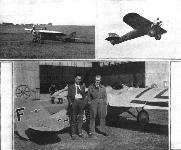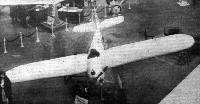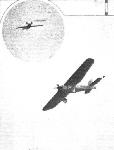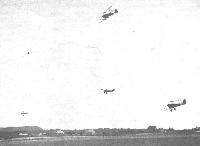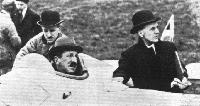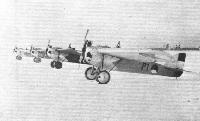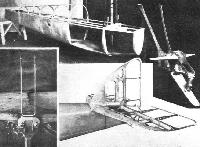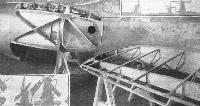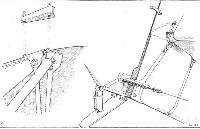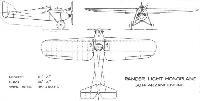
Варианты
- Carley - C.12 - 1923 - Нидерланды
- Holland (VIH) - H.2 - 1924 - Нидерланды
Pander. Самолеты
В августе 1924 года Хенк Пандер, производитель мебели, купил бывший авиационный завод фирмы "Holland" вместе с одним из ее самолетов, монопланом Holland H-2. У истоков фирмы "Holland" стоял Йооп Карли, построивший несколько самолетов в 1917 году, а затем объединивший свои усилия с инженером Тео Слотом. Последним проектом Карли стал одноместный моноплан Carley C-12 с 20-сильным (15 кВт) ПД Anzani, построенный в 1922 году. Самолет C-12 был продемонстрирован на выставках в Париже, Брюсселе и Лондоне, а его разработка продолжилась и после того, как Карли организовал новую фирму "Holland" возле Гааги. Самолету дали новое обозначение - Holland H-2 (H-1 был бипланом) и оснастили 25-сильным (19 кВт) ПД Anzani, но был построен только один экземпляр.
После покупки X. Пандером завода "Holland" и создания новой компании "Nederlandse Fabriekvan Vliegtuigen Н. Pander & Zn", работа над H-2 была продолжена, но уже под обозначением Pander D. Самолет сохранил прежний двигатель, а его первый полет состоялся 16 ноября 1924 года.
В общей сложности построили 11 самолетов этого типа, включая девять Pander D, один DB и один DF.1. В июле 1925 года два самолета D были поставлены ВМС Нидерландов, а еще два в ноябре - в ВВС Голландской Ост-Индии. По одному самолету получили Испания и Франция, где машину оснастили 45-сильным (34 кВт) двигателем Anzani. Остальные Pander D остались в Голландии, также как и Pander DB с двигателем Bristol Cherub и DF.I с 40-сильным (30 кВт) двигателем A.B.C. Scorpion.
Но наиболее удачной разработкой стал следующий самолет, биплан Pander E, построенный в количестве 17 экземпляров, имевших общую базовую конструкцию, но отличавшихся типом силовой установки. Прототип поднялся в воздух в Ваальхавене 18 февраля 1926 года, нов августе потерпел катастрофу в Дортмунде. Тем не менее покупателями самолета стали NLS (Голландская национальная авиашкола), получившая девять машин, и Аэроклуб Роттердама, получивший три машины. Первые шесть Pander E сохранили деревянный фюзеляж, но, начиная с седьмой машины, его заменили на конструкцию из стальных труб. Варианты включали EC с 60-сильным (45 кВт) ПД Walter IV, EF с двигателем Walter Vega в 85 л. с. (63 кВт), EG со 100-сильным (75 кВт) de Havilland Gipsy I и единственный EH со 120-сильным (89-кВт) de Havilland Gipsy III. В вариант EK, ставший последним в серии, был переделан один из EC, получивший регистрацию в марте 1933 года. Как минимум три самолета уцелели до мая 1940 года, когда они были уничтожены немцами, и еще три других использовались в Голландских Вест-Индии и Ост-Индии.
<...>
Описание:
- Pander. Самолеты
- Flight, November 1924
THE "HOLLAND" LIGHT PLANES - Flight, December 1924
The Paris Aero Show 1924 - Flight, February 1925
THE PANDER LIGHT MONOPLANE
Фотографии
-
Flight 1924-11 / Flight
Регистрационный номер: H-NACE The "Holland H.2" Light 'Plane: This is a single-seater monoplane, a development of the Carley light monoplane built last year. It has a 25 h.p. Anzani engine.
-
Flight 1925-07 / Flight
Регистрационный номер: H-NACO [3] SOME LIGHT PLANES COMPETING AT LYMPNE: The Pander monoplane with 30 h.p. French Anzani.
-
Flight 1925-04 / Flight
Регистрационный номер: H-NACO [3] THE PANDER LIGHT MONOPLANE AT CROYDON: This side view gives a good idea of the size of the machine.
-
Flight 1925-04 / Flight
Регистрационный номер: H-NACO [3] THE PANDER LIGHT MONOPLANE WITH ANZANI ENGINE: Three-quarter rear view.
-
Flight 1926-08 / Flight
Регистрационный номер: F-AIDZ [2] THE FRENCH LIGHT 'PLANE COMPETITION AT ORLY: The eight competing machines: 8. No. 16, Roques-Lefolcalvez (pilot, Roques or Lefolcalvez).
-
Flight 1926-08 / Flight
Регистрационный номер: F-AIDZ [2] No. 16: The French-built Pander monoplane entered and flown by MM. Roques and Lefolcalvez, who are seen standing by the machine. Above: left, making a good landing in the tests, and, right, in flight. A poor engine prevented this machine from doing itself justice.
-
Flight 1924-12 / Flight
The prettiest machine in the Show: The Pander light monoplane, with Y-type Anzani.
-
Flight 1925-04 / Flight
The Pander monoplane coming in to alight after a flight at Croydon, and, inset, a photograph of the machine flying upside-down.
-
Flight 1925-08 / Flight
HEADING FOR POSTLING: In the lead is the Airdisco "Avro," followed by the Pander monoplane, above which is seen the De Havilland "Moth" flown by Broad, with Cobham on the second "Moth" in hot pursuit.
Другие самолёты на фотографии: Avro Type 548 - Великобритания - 1919De Havilland Moth / D.H.60 - Великобритания - 1925
-
Flight 1925-04 / Flight
The Undercarriage of the Pander light monoplane, and the neat engine cowling around the Anzani engine.
-
Flight 1925-04 / Flight
The Pander Light Monoplane at Croydon: The Air Ministry is interested. General Brancker (in situ), on the right Major Buchanan, and behind Col. Darby, with a watching brief.
-
Flight 1925-12 / Flight
Light 'planes for East India: A batch of Pander light monoplanes built for Dutch East Indies. Note the tubular cabane added over the cockpit to protect the pilot's head in a crash.
-
Flight 1925-02 / Flight
Two Pander light monoplanes in course of construction.
-
Flight 1925-02 / Flight
THE PANDER LIGHT MONOPLANE: Above, a view of the fuselage in course of construction. Below, the tail. On the right, the tail skid and fittings, and on the left, one of the U-bolts which secure the wing spars to the fuselage.
-
Flight 1925-09 / Flight
SOME DETAILS OF PANDER CONSTRUCTION: On the left, a fuselage, upside down, on its trestles, showing the keel and diagonal' members of the structure. On the right, a wing, also upside down, showing spars, ribs, etc. The wing tip rib is of U-section, and built up from numerous laminations. On the top surface the ply-wood covering of the leading edge extends a considerable distance aft of the front spar.
-
Flight 1925-09 / Flight
TWO VIEWS IN THE PANDER WORKS AT THE HAGUE: On the left, fuselages, wings, etc., of the Pander monoplane. On the right, a single-seater fuselage and one of the wings of the two-seater, which is now nearing completion.
-
Flight 1924-12 / Flight
ON THE PANDER LIGHT MONOPLANE: On the right the sprung tail skid, which is mounted on, and moves with, the rudder. On the left the attachment of the rear chassis strut and rear spar U-bolt. Straps run down the sides of the monocoque fuselage so as to distribute the loads.
-
Flight 1925-02 / Flight
Pander Light Monoplane 30 hp Anzani Engine
- Фотографии





